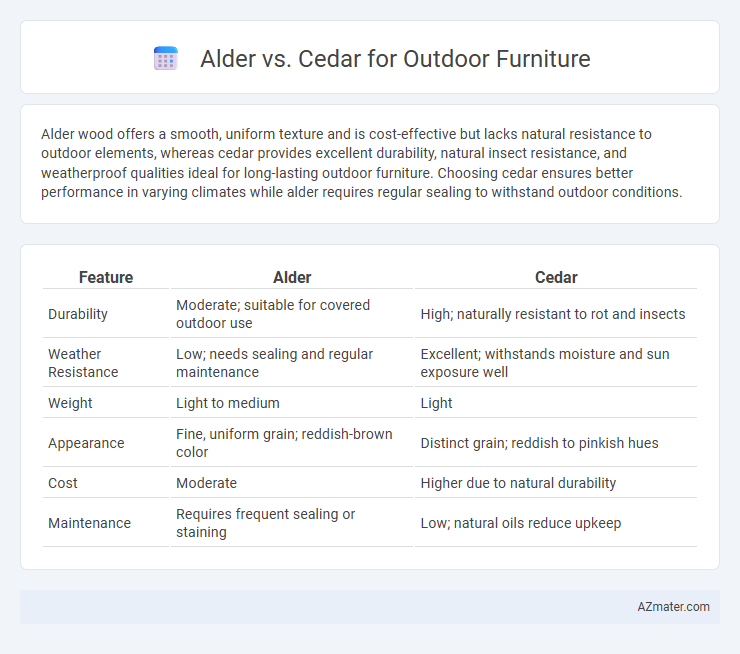Alder wood offers a smooth, uniform texture and is cost-effective but lacks natural resistance to outdoor elements, whereas cedar provides excellent durability, natural insect resistance, and weatherproof qualities ideal for long-lasting outdoor furniture. Choosing cedar ensures better performance in varying climates while alder requires regular sealing to withstand outdoor conditions.
Table of Comparison
| Feature | Alder | Cedar |
|---|---|---|
| Durability | Moderate; suitable for covered outdoor use | High; naturally resistant to rot and insects |
| Weather Resistance | Low; needs sealing and regular maintenance | Excellent; withstands moisture and sun exposure well |
| Weight | Light to medium | Light |
| Appearance | Fine, uniform grain; reddish-brown color | Distinct grain; reddish to pinkish hues |
| Cost | Moderate | Higher due to natural durability |
| Maintenance | Requires frequent sealing or staining | Low; natural oils reduce upkeep |
Introduction: Comparing Alder and Cedar for Outdoor Furniture
Alder and cedar are popular wood choices for outdoor furniture due to their durability and aesthetic appeal. Cedar naturally resists moisture, decay, and insect damage, making it ideal for outdoor conditions, while alder offers a smooth texture and rich reddish-brown hue but requires protective finishes to withstand weather exposure. Understanding the differences in wood grain, maintenance needs, and weather resistance helps in selecting the best material for long-lasting outdoor furniture.
Durability and Weather Resistance
Cedar is highly valued for outdoor furniture due to its natural oils that provide superior resistance to moisture, decay, and insect damage, making it more durable in harsh weather conditions compared to alder. Alder, while aesthetically similar to cherry wood, is softer and more prone to damage and less resistant to prolonged exposure to rain and humidity. For long-lasting outdoor use, cedar's inherent weather-resistant properties ensure furniture remains sturdy and visually appealing over time.
Natural Appearance and Color Variations
Alder wood offers a smooth, fine-grained texture with warm reddish-brown hues that deepen over time, providing a rich natural appearance for outdoor furniture. Cedar displays prominent grain patterns with a range of colors from light amber to deep chestnut, often featuring natural knots that enhance its rustic charm. Both woods exhibit distinctive color variations, but cedar's inherent resistance to weathering makes its appearance more durable in outdoor settings.
Workability and Ease of Crafting
Alder wood offers excellent workability due to its fine, even grain and softness, making it easier to cut, shape, and sand for outdoor furniture projects. Cedar, while slightly harder, provides natural resistance to decay and insects, but its aromatic oils can sometimes dull blades faster. Both woods are relatively easy to craft, though alder is favored for intricate designs and smooth finishes, whereas cedar excels in durability and weather resistance.
Resistance to Insects and Decay
Cedar wood is highly resistant to insects and decay due to its natural oils and aromatic compounds, making it a preferred choice for outdoor furniture exposed to harsh environmental conditions. Alder wood lacks the same level of natural insect-repellent properties and is more susceptible to moisture damage and decay when used outdoors without proper treatment. For long-lasting outdoor furniture, cedar provides superior durability against pest infestation and rot, reducing maintenance needs over time.
Maintenance Requirements
Alder wood requires moderate maintenance for outdoor furniture, including regular sealing and occasional sanding to prevent moisture damage and decay. Cedar is highly resistant to rot and insects, demanding less frequent sealing and minimal upkeep, making it ideal for outdoor use. Both woods benefit from periodic cleaning to maintain appearance and prolong durability in various weather conditions.
Cost and Availability
Alder wood is generally more affordable than cedar, making it a cost-effective choice for outdoor furniture projects. Cedar, while pricier, is widely available in many regions due to its natural resistance to decay and insects, which often justifies the higher expense. Both woods offer good availability, but alder's lower price point appeals to budget-conscious buyers seeking durable outdoor furnishings.
Environmental Impact and Sustainability
Alder wood is less dense and grows faster than cedar, resulting in a smaller carbon footprint and quicker replenishment in sustainable forestry practices. Cedar's natural resistance to decay and insects reduces the need for chemical treatments, enhancing its eco-friendliness and longevity in outdoor furniture applications. Both woods offer renewable options, but alder's rapid growth cycles contribute to lower environmental impact over time compared to cedar.
Best Uses for Alder vs Cedar Outdoors
Alder wood offers a smooth grain and moderate durability, making it ideal for decorative outdoor furniture pieces such as benches and tables that benefit from a fine finish but are sheltered from harsh weather. Cedar is naturally resistant to moisture, decay, and insects, which makes it the best choice for outdoor furniture exposed to the elements, including patio sets and garden chairs, providing longevity and minimal maintenance. Both woods perform well when sealed, but cedar's superior weather resistance and aromatic properties give it a distinct advantage for outdoor use.
Conclusion: Choosing the Right Wood for Your Outdoor Furniture
Alder offers a smooth texture and affordable price but lacks the natural resistance to decay and insects that cedar provides, making cedar a more durable long-term choice for outdoor furniture. Cedar's natural oils and density provide superior weather resistance and longevity, minimizing maintenance needs and preserving outdoor aesthetics. Selecting cedar ensures a balance of durability, beauty, and performance ideal for outdoor environments.

Infographic: Alder vs Cedar for Outdoor Furniture
 azmater.com
azmater.com